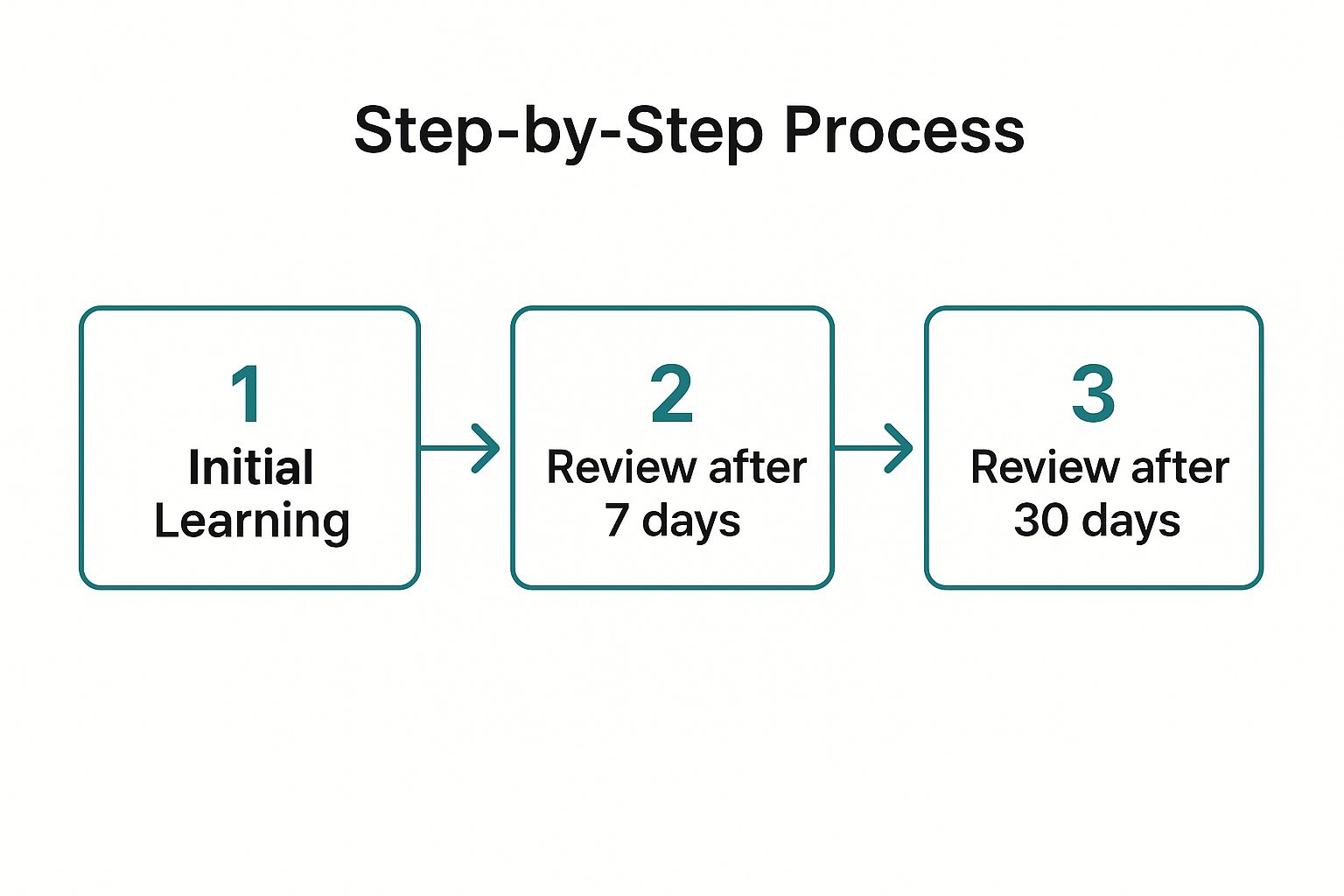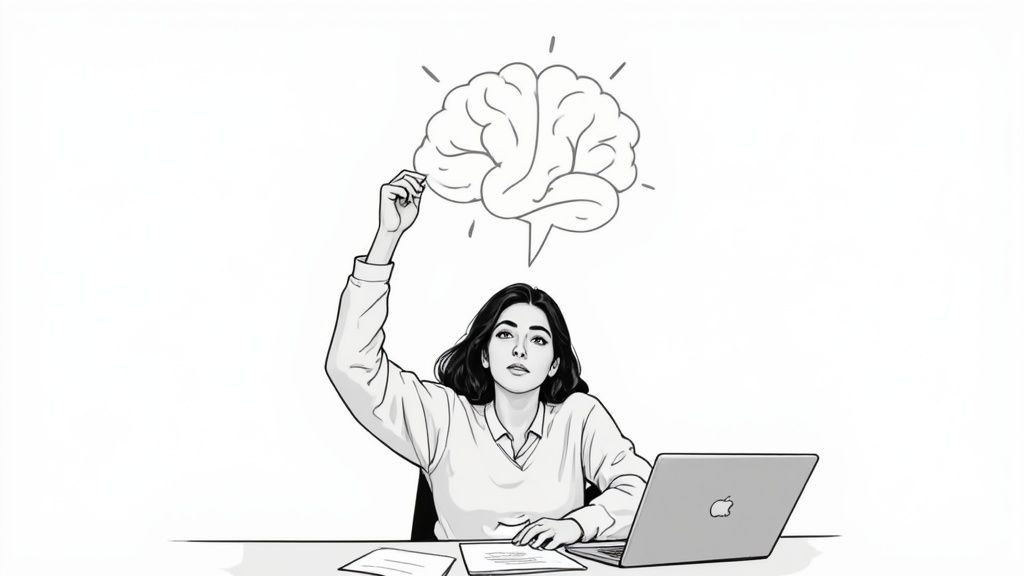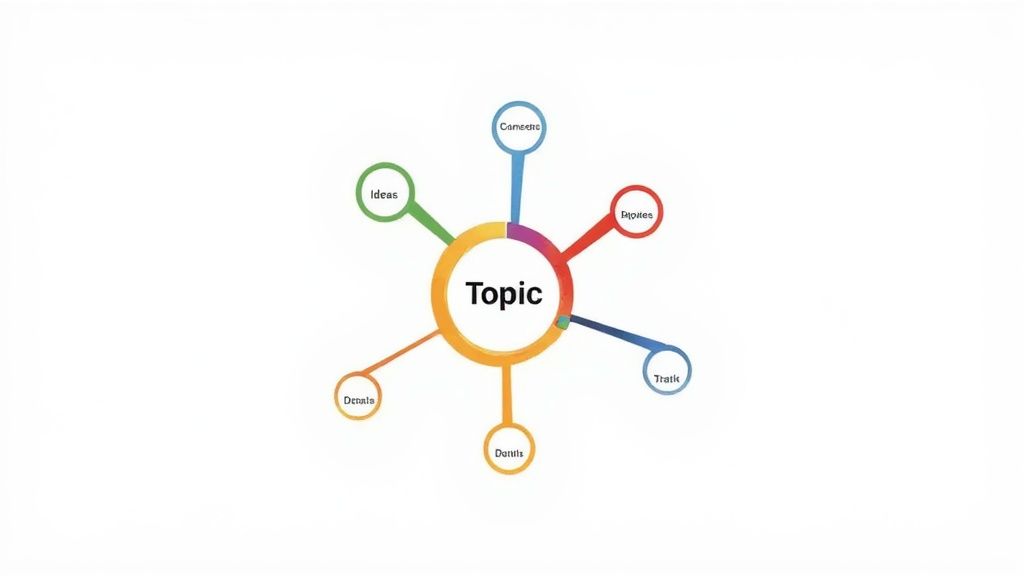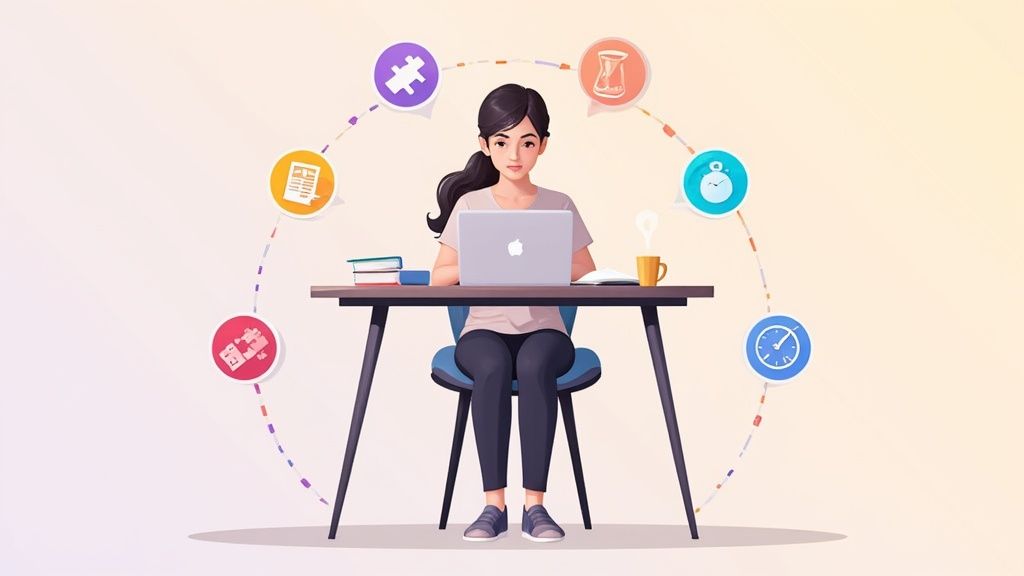Ever spent hours staring at a textbook, only to feel like it all vanished by exam day? It’s a classic student nightmare, and it happens because most of us were never actually taught how to learn the right way. We fall back on just re-reading stuff and frantic, last-minute cram sessions—tactics that feel productive but totally sabotage long-term memory. The good news is that there’s a much better way. This isn't about studying harder; it's about studying smarter by using powerful, proven student learning strategies.
This guide cuts through the noise. We've put together 10 battle-tested methods straight from brain science that will change how you absorb, retain, and recall info. Forget vague tips like “study more.” Instead, you’ll get real techniques like Spaced Repetition, the Feynman Technique, and Active Recall, with simple steps to start using them right away. Each one is a tool to make your study sessions more efficient, less stressful, and way more effective. Get ready to transform how you learn and finally make information stick.
1. Spaced Repetition
Forget cramming. One of the most powerful, science-backed student learning strategies is spaced repetition. This trick fights against your brain's natural tendency to forget things over time. Instead of hitting a topic hard all at once, you strategically review the info at increasing intervals. This simple shift tells your brain, "Hey, this is important!" helping to move it from your flaky short-term memory to your more reliable long-term storage.
How It Works
Spaced repetition uses a psychological trick known as the "spacing effect." When you first learn something, like a key historical date or a complex formula, the memory is fragile. By revisiting it just as you're about to forget, you strengthen the brain pathways for that memory. Each review makes the memory tougher, letting you wait longer before the next study session.
This approach is a lifesaver for subjects that require memorizing tons of information, like medical terms, legal cases, or a new language. It turns studying from a frantic, last-minute panic into a chill, long-term process.
The infographic below shows a basic flow for how to do it.

This visual process shows how reviewing material at specific, lengthening intervals helps lock in knowledge over time.
Putting It into Practice
- Use Digital Tools: Apps like Anki, Quizlet, and RemNote have built-in algorithms that automatically schedule your review sessions. This takes all the guesswork out of it.
- Start Early: Spaced repetition isn't a last-minute hack. Begin reviewing new stuff within a day of learning it and keep it up all semester.
- Combine with Active Recall: Don't just re-read your notes. Test yourself. Use flashcards where you try to pull the answer from your brain before checking. This combo is a true memory-building powerhouse. Learn more about effective ways to retain information here.
2. Active Recall (Retrieval Practice)
Stop just re-reading your notes. Active recall, also called retrieval practice, is a student learning strategy that flips studying on its head. Instead of passively soaking up info by reading or watching, you actively pull information out of your brain. This effort of retrieving a memory is what makes it stronger, making it way easier to access during an exam.

How It Works
Think of your brain like a muscle. Each time you force yourself to remember a concept, formula, or definition without looking at your notes, you're doing a "rep" that strengthens the connections for that piece of info. This is way more effective than passive review, which often creates a false sense of confidence where you recognize material but can't actually recall it from scratch.
Cognitive psychologists have shown that testing yourself is one of the most powerful study methods out there. Studies show students who use practice exams score a lot higher than those who just re-read textbooks. It's the difference between recognizing a friend's face in a crowd and having to draw it from memory.
Putting It into Practice
- Quiz Yourself: After a lecture, close your book and write down everything you remember. This "brain dump" immediately puts active recall to work.
- Explain It Aloud: Try explaining a complex topic to a friend (or your pet). If you get stuck, you've found a gap in your knowledge. This is a key part of the Feynman Technique.
- Create Your Own Questions: Don't wait for a practice exam. As you study, make up questions about the material. Answering them later is a perfect form of retrieval practice.
- Use Flashcards Right: The power of flashcards comes from trying to remember the answer before you flip the card. Don't peek too early; the struggle is part of the learning process.
3. Feynman Technique
True understanding isn't about memorizing complicated jargon; it's about being able to explain a tough idea in simple terms. This is the main idea behind the Feynman Technique, a powerful method for deep learning named after Nobel Prize-winning physicist Richard Feynman. It forces you to go beyond just recognizing a concept and actually wrestle with it until you can explain it clearly. If you can’t teach it, you don’t really know it.
How It Works
The Feynman Technique is all about learning by teaching. The process has four key steps: pick a concept, explain it to a total beginner (even an imaginary one), figure out where you're fuzzy when you get stuck, and finally, go back and simplify your explanation. It's a mental stress test that instantly shows you where your knowledge is weak.
This is one of the best student learning strategies for mastering complex topics in things like physics, computer science, or philosophy. By forcing you to use simple language and analogies, you build stronger, more intuitive brain connections to the material, making it easier to remember and use later.
Putting It into Practice
- Pretend You're Teaching a Kid: Write or say your explanation as if you're talking to a 12-year-old. This makes you ditch all the technical jargon and focus on the core ideas.
- Find Your Knowledge Gaps: The moment you stumble or say "um, basically..." is a big deal. That's the exact spot where your understanding is weak. Go back to your notes, fill that gap, and then try explaining again.
- Use Analogies and Visuals: Compare a difficult concept to something simple. A business student might explain economic theories using a household budget, or a computer science student might use LEGOs to describe an algorithm.
- Create a "Feynman Notebook": Keep a dedicated notebook with your simplified explanations of the toughest concepts from each class. This becomes an amazing, personalized study guide for exams.
4. Pomodoro Technique
If long study sessions feel like a drag, it’s time to try the Pomodoro Technique. This time management method breaks your work into focused, bite-sized chunks. Instead of trying to study for hours straight, you work in 25-minute sprints (called "pomodoros") with short breaks in between. This trick uses time pressure to boost your focus, prevent burnout, and make even the biggest tasks feel less scary.

How It Works
The Pomodoro Technique beats procrastination by making it easy to start. Committing to just 25 minutes of focused work is way less intimidating than facing a three-hour study block. After each pomodoro, you take a 5-minute break to recharge. Once you complete four pomodoros, you get a longer 15-30 minute break.
This cycle helps train your brain to focus for short periods and rests it before you get tired. It's a great student learning strategy because it turns studying into a game and gives your time a clear structure. The technique is perfect for writing a paper, prepping for an exam, or just getting through homework without feeling totally overwhelmed.
Putting It into Practice
- Kill Distractions: Before starting a pomodoro, turn off all notifications. Put your phone in another room to create a real focus zone.
- Plan Your Sprints: Decide what specific task you'll work on during each 25-minute slot. This clarity keeps you from wasting time figuring out what to do next.
- Respect the Break: Your 5-minute breaks are a must. Get up, stretch, or grab a glass of water. Try not to check your phone or email, as this can pull you out of your study zone. For more on the method, you can visit Francesco Cirillo's official website.
5. SQ3R Method (Survey, Question, Read, Recite, Review)
Just reading your textbook is one of the biggest time-wasters in studying. The SQ3R Method is a classic student learning strategy made to turn that passive skimming into an active, engaging process. It’s a five-step reading plan that forces you to interact with the material, which seriously improves how well you understand and remember dense stuff like textbook chapters or academic articles.
How It Works
Developed by a psychologist, SQ3R is a structured way to tackle your reading from start to finish. The five steps build on each other: you Survey the text to get the big picture, form Questions based on headings, Read actively to find the answers, Recite the info in your own words, and finally Review it to lock in your learning. This turns reading from just letting your eyes scan words into a mission to find answers.
This method is a game-changer for anyone facing scary reading assignments, like a pre-med student tackling a dense biology chapter or a business major analyzing a complex case study. It gives you a clear roadmap to break down and understand tough material, making the whole thing more efficient. By engaging with the text this way, you can learn how to process information faster.
Putting It into Practice
- Be a Detective: Before reading, spend 5-10 minutes on the Survey step. Skim headings, captions, and summaries. Then, turn each heading into a Question. This gets your brain ready for what to look for.
- Active Reading: As you Read, your goal is to answer the questions you just made. Highlight or jot down the key info that answers your questions.
- Say It Out Loud: For the Recite step, put the book down and summarize the key points of a section out loud or in writing without looking. If you can't explain it simply, you haven't understood it well enough.
- Schedule a Review: Don't just finish and forget. Plan a quick Review of your notes within 24 hours. This first review is super important for moving the info into long-term memory.
6. Mind Mapping
Ditch the boring, text-heavy notes. A really fun and brain-friendly student learning strategy is mind mapping. This technique means creating a diagram that starts with a central idea and branches out into related topics. It's designed to work how your brain naturally makes connections, using colors, images, and keywords to create a memorable and easy-to-understand picture of complex information.

How It Works
Mind mapping gets both your logical and creative brain working together. The main concept is your anchor in the middle, with big ideas forming the main branches. From there, you add more detailed info on smaller, connected branches. This setup helps you see the big picture and the tiny details at the same time, making the relationships between different pieces of info super clear.
This method is incredibly flexible. It's perfect for brainstorming essays, summarizing lectures, or creating a full study guide for an exam. For example, a biology student could map out the entire process of photosynthesis, while a history student could visualize all the connected causes of World War II.
The video above is a great visual guide to creating your first mind map and unlocking its full potential.
Putting It into Practice
- Start with a Central Image: Begin in the center of a blank page with a drawing or keyword for your main topic. This keeps your focus locked in.
- Use Color and Keywords: Give different colors to your main branches to visually separate themes. Keep labels short, using just one to three keywords per branch.
- Embrace Visuals: Add little drawings, icons, and symbols to your map. These visual cues are powerful memory triggers, making it much easier to remember stuff.
- Go Digital: If you're more of a tech person, tools like MindMeister, XMind, or Coggle let you create awesome, easily editable mind maps.
7. Interleaving
Break the cycle of boring study sessions. Interleaving is one of the most effective student learning strategies, but it often feels a bit weird at first. It involves mixing up different topics or types of problems in a single study session, rather than practicing one thing over and over (which is called "blocked practice"). By forcing your brain to switch gears, you get better at telling concepts apart and choosing the right solution for different problems.
How It Works
Interleaving strengthens your long-term memory by making your brain work harder to find information. When you practice in blocks, you know exactly what formula or rule to use. When you interleave, you have to first figure out the type of problem before you can solve it. This process of telling concepts apart builds a more flexible and deeper understanding that you can use in new situations, like on an exam where all the questions are mixed up.
While it can feel harder and slower when you're doing it, the long-term payoff is huge. This "desirable difficulty" is the key to building solid knowledge. For example, a math student who switches between algebra, geometry, and trigonometry problems will do better than a student who studies each topic in separate, long blocks.
Putting It into Practice
- Mix It Up: Instead of doing 20 questions on a single chemistry topic, make a practice set with 5 questions each from four different-but-related topics. Switch it up every few problems.
- Start with Blocks, then Interleave: When you're learning something brand new, it's okay to start with a few blocked practice problems to get the hang of it. Just switch to interleaving as soon as you've got the basic idea down.
- Trust the Process: You might feel like you're doing worse when you interleave because it's more challenging. See this as a sign that you're learning effectively, not failing. The struggle is what makes the knowledge stick.
8. Dual Coding (Visual and Verbal Learning)
Unlock your brain's full potential by using one of the most natural student learning strategies: dual coding. This method is based on the idea that we learn and remember stuff better when it's presented in two ways: words and pictures. Instead of just reading text, you combine it with relevant images, diagrams, or sketches. This creates two different paths for your brain to store and retrieve the information, which really boosts your recall.
How It Works
Dual coding theory says our brains have separate channels for handling words and visuals. When you use both channels at the same time, you create a stronger, more connected memory. Think of it like giving your brain a map and a set of written directions to the same place; if one fails, you have a backup.
This approach is super flexible and works for pretty much any subject. For biology, you might draw and label a cell while reading about what it does. For history, you could create a cool illustrated timeline instead of just listing dates. This simple act of turning text into a visual forces you to think more deeply and makes abstract concepts more real and easier to grab onto.
Putting It into Practice
- Sketch It Out: You don't have to be an artist. Simple stick figures, flowcharts, and diagrams work great. The goal is to represent the concept visually, not create a masterpiece.
- Create Visual Metaphors: For abstract ideas like economic inflation, you could draw a deflating balloon next to your written notes. This creates a memorable visual anchor for the concept.
- Combine with Other Methods: Dual coding and mind mapping are a perfect match. Create branches with keywords (verbal) and add little icons or drawings (visual) to lock in each point.
- Use Color Coding: Give specific colors to related themes or categories across your notes. This adds another layer of visual organization that helps your brain make connections. Explore other ways to engage multiple senses with your studies by understanding more about multimodal learning.
9. Elaborative Interrogation
Stop passively accepting facts and start asking "why" and "how." Elaborative interrogation is a powerful student learning strategy where you actively question the material you're studying. By coming up with explanations for why a fact is true or how a process works, you force your brain to connect new information with what you already know. This whole process of asking and explaining builds a deeper, more meaningful understanding that actually sticks.
How It Works
This technique uses your natural curiosity to build stronger brain connections. When you ask "Why do plant cells have a cell wall but animal cells don't?" you're not just memorizing a fact; you're exploring the reasons behind it related to structure, environment, and function. This deep thinking makes the information stand out and makes it easier to remember later on.
Elaborative interrogation is especially good for learning facts and concepts in subjects like history, biology, and physics. It pushes you to think critically about cause-and-effect and the big ideas behind the concepts, turning you from a passive receiver of information into an active participant in your own learning.
Putting It into Practice
- Turn Statements into Questions: When you read something like "The Treaty of Versailles contributed to the outbreak of World War II," immediately ask, "How did its terms create the right conditions for another war?" or "Why was it so harsh?"
- Explain and Connect: Try to answer your own questions first, using what you already know, before you check your textbook. Connect the new stuff to personal experiences or things you learned in other classes to make it more memorable.
- Write It Down: Putting your explanations in writing helps clear up your thoughts and quickly shows you any gaps in your understanding that you need to review.
- Discuss with Peers: Talk through your "why" and "how" explanations with a study group. Debating different ideas and sharpening your reasoning together is an awesome way to make complex concepts stick.
10. Cornell Note-Taking System
Time to ditch those messy, disorganized notes. A classic for a reason, the Cornell Note-Taking System is a structured method that turns passive listening into active learning. Developed by a Cornell University professor, this technique divides a single page into different sections to help you record, organize, and review information way more effectively. It’s one of the most practical student learning strategies for turning your lecture notes from a simple transcript into a powerful study tool.
How It Works
The magic of the Cornell method is its simple but brilliant layout. You split your page into three main areas: a large column on the right for taking notes during the lecture, a smaller column on the left for cues or questions, and a summary section at the bottom. During class, you jot down your main notes in the right column. Afterward, you pull out key ideas, questions, and keywords from your notes and put them in the left "cue" column. Finally, you boil down the entire page into a one or two-sentence summary at the bottom.
This structure forces you to engage with the material multiple times: once during the lecture, again when making cues, and a third time while summarizing. This active process seriously boosts understanding and memory, making it perfect for lecture-heavy courses like history, psychology, or science.
Putting It into Practice
- Prep Your Pages: Before class, draw the lines on your paper or use a digital template in an app like Notion or OneNote to set up your sections.
- Review and Cue: Within 24 hours of the lecture, go over your notes. Pull out main ideas and form questions in the left column. This step is super important for making the information stick.
- Summarize Immediately: Write your summary at the bottom of the page right after you finish reviewing and creating cues. This helps you get the big picture while the details are still fresh.
- Test Yourself: To study, cover the right-hand notes column and try to answer the questions or explain the concepts from your cue column. This combines the Cornell method with active recall for a killer combo.
Student Learning Strategies Comparison Chart
| Technique | Implementation Complexity 🔄 | Resource Requirements ⚡ | Expected Outcomes 📊 | Ideal Use Cases 💡 | Key Advantages ⭐ |
|---|---|---|---|---|---|
| Spaced Repetition | Moderate - needs scheduling & consistent practice | Flashcards/software (Anki, Quizlet) | Long-term memory, less study time | Memorization-heavy subjects (languages, med terms) | Scientifically proven; stops forgetting; super efficient |
| Active Recall | Moderate - takes effort to self-test | Flashcards, practice questions, or just your voice | Way better retention and engagement | Any subject; especially clutch before exams | Finds knowledge gaps; builds confidence; reduces test anxiety |
| Feynman Technique | High - takes time to explain and re-explain | No special tools needed | Deep understanding of concepts | Tough concepts in STEM, philosophy, economics | Shows you what you don't know; makes you a better communicator |
| Pomodoro Technique | Low - just a simple timing method | Timer or app | Better focus and productivity, less burnout | Time management; any learning or work task | Easy to start; builds good habits; stops procrastination |
| SQ3R Method | Moderate - a multi-step reading process | Textbooks, note-taking stuff | Better reading comprehension | Academic textbooks, dense reading | A structured plan; improves focus; creates study notes |
| Mind Mapping | Moderate - needs some creativity and organization | Paper/digital tools (MindMeister, XMind) | Better memory through visual organization | Brainstorming, planning, note-taking | Boosts creativity; shows connections; makes info memorable |
| Interleaving | Moderate - requires planning to mix topics | Varied practice materials | Better memory and problem-solving | Subjects with related topics; exam prep | Helps you tell concepts apart; better for real-world use |
| Dual Coding | Moderate - have to create visuals with words | Drawing tools, digital visuals | Better memory and understanding | Visual learners; abstract or complex ideas | Creates two memory paths; makes abstract ideas concrete |
| Elaborative Interrogation | Moderate to high - requires active questioning | No special tools needed | Deeper understanding and memory | Subjects needing critical thinking | Boosts critical thinking; connects new to old knowledge |
| Cornell Notes | Moderate - needs structured organization | Paper or digital note tools | Organized notes; easier review and recall | Lecture-based classes; any subject | Pushes you to review actively; easy to do; improves focus |
Your New Toolkit for Smarter Learning
There you have it—ten powerful, evidence-backed student learning strategies to completely change how you study. We've looked at techniques that challenge the old way of doing things, moving away from the cozy comfort of highlighting and re-reading toward more active, effective methods. The main message in all of them, from Spaced Repetition to the Cornell System, is simple but huge: learning is an active process.
Real understanding isn't built by letting information wash over you; it's made by actively wrestling with it. This means pulling facts from your memory with Active Recall, untangling complex ideas by explaining them with the Feynman Technique, and managing your focus with the Pomodoro Technique. It’s about creating connections, not just collecting facts.
From Theory to Action: Your Next Steps
The goal isn't to get overwhelmed by a long list of new tactics. Instead, think of these ten methods as a toolkit. You don't need every tool for every job. The key is to start small and be smart about it.
Here’s a simple plan to get started:
- Find Your Biggest Challenge: Are you struggling with remembering formulas for a physics exam? Start with Spaced Repetition and Active Recall. Is a dense history textbook putting you to sleep? Give the SQ3R Method a try.
- Pick One or Two Strategies: Choose the techniques that seem most helpful for your current headache. Commit to using them consistently for a specific class or for the next two weeks.
- Stack and Combine: Once you're comfortable, start mixing these student learning strategies together for an even bigger impact. Use the Cornell Method for your lecture notes, then create Mind Maps to see the connections. Turn those Mind Maps into flashcards for Spaced Repetition with Active Recall. This is how you build a powerful, personalized system.
The Real Prize: Lifelong Learning
Mastering these techniques does more than just get you ready for your next exam. It gives you a framework for learning that will help you long after you've left school. In a world where you always have to learn new things, knowing how to learn is the ultimate superpower. By embracing these student learning strategies, you aren't just studying for a grade; you're investing in your ability to adapt, grow, and succeed in whatever you choose to do. You're building the confidence that comes from really understanding something and the strength to tackle any complex subject that comes your way.
P.S. Want to reinforce these learning concepts while you're commuting, at the gym, or just taking a break? Turn this article (or any of your study notes) into an audio lesson. With podcast-generator.ai, you can convert text into a high-quality, listenable podcast in minutes, making it a perfect tool to integrate Dual Coding and Spaced Repetition into your routine. Give your eyes a rest and your brain a new way to learn at podcast-generator.ai.
